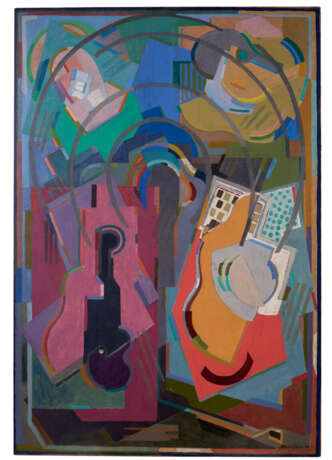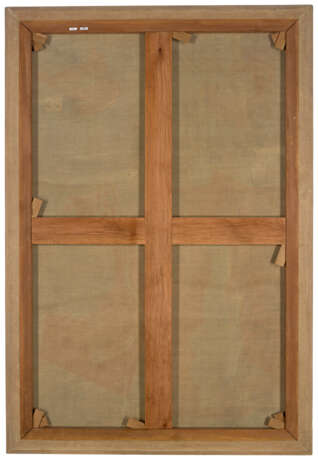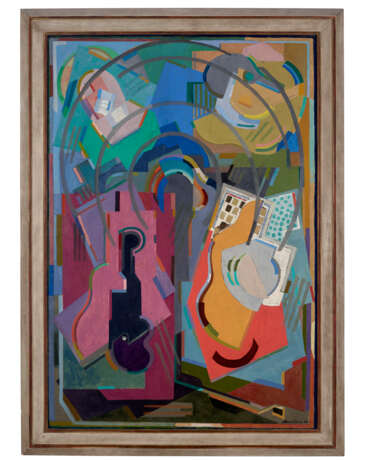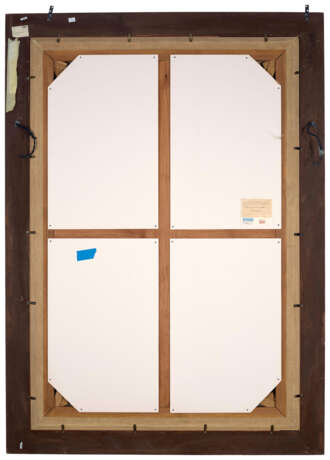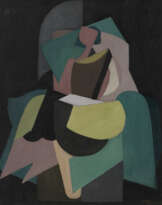ID 1178633
Lot 119 | Albert Gleizes (1881-1953)
Estimate value
€ 120 000 – 180 000
Composition rythmique, quatre éléments
signé et daté 'Albert Gleizes 24-25' (en bas à droite)
peinture à l'essence sur toile
190.4 x 130 cm.
Peint en 1924-25; retravaillé en 1934
signed and dated 'Albert Gleizes 24-25' (lower right)
peinture à l'essence on canvas
74 7⁄8 x 51 ¼ in.
Painted in 1924-25; reworked in 1934
Provenance
Paul Rosenberg, Paris.
André Schoeller, Paris.
Marvin Lundy, Philadelphie; vente, Sotheby's, New York, 14 novembre 1985, lot 252.
Acquis au cours de cette vente par le propriétaire actuel.
Literature
A. Varichon, Albert Gleizes, Catalogue raisonné, Paris, 1998, vol. I, p. 386, no. 1190 (état antérieur à 1934 illustré et état actuel illustré en couleurs).
Exhibited
Lyon, Chapelle du Lycée Ampère, Albert Gleizes, Le Cubisme et son dénouement dans la tradition, novembre-décembre 1947, no. 25 ou 26.
Chambéry, Maison des Jeunes et de la Culture, Exposition Albert Gleizes, octobre-novembre 1968, no. 20.
Further details
Dans La Peinture et ses lois, Albert Gleizes affirme : «peindre, c’est donner vie à une surface plane ; donner vie à une surface plane c’est transformer son espace en rythme» (La Peinture et ses lois, 1923). Entre 1922 et 1934, les expériences de Gleizes sur la visualisation du rythme expriment l’importance pour lui de l’association de la «translation» et de la «rotation», qui caractérisent bientôt la dimension picturale et l’aspect théorique de son travail. En pratique, cela signifie que si la surface générale est un rectangle, par exemple, la «translation», agréable à l’oeil au repos, est une simple répétition de ces proportions, parallèlement aux bords de la toile, alors que la «rotation» est obtenue en inclinant les plans, vers la droite ou la gauche, de façon à ce que, pour ainsi dire, l’oeil imagine que le plan lui-même tourne et le suive. Cependant, Gleizes rapportera plus tard : «J’ai rapidement compris que je devrais accepter une discipline. J’ai adopté un principe de compartimentation, où les rapports et les proportions s’organisent en harmonie avec le rapport initial de hauteur et de largeur donné par la surface générale à peindre. C’est ainsi que j’ai fait une série de tableaux... que j’ai donc appelés, selon le cas, Tableau avec deux, trois, quatre, sept éléments» (Albert Gleizes, Souvenirs 1934-39). La présente œuvre, qui fait partie d’un certain nombre de variations sur un thème, contient quatre éléments colorés et visuellement divertissants, chacun associant des formes rigides et ondulantes. La « compartimentation » de l’espace par Gleizes, ainsi que l’association entre la juxtaposition de couleurs intenses et de plans mobiles imbriqués qui semblent tourner sur des axes obliques font de Composition rythmique, quatre éléments une oeuvre incroyablement intense du point de vue optique. Composition rythmique, quatre éléments est achevé en 1925, année où le Bauhaus (qui met en pratique certains idéaux analogues aux siens) commande à Gleizes un nouveau livre sur le cubisme. Il doit faire partie d’une série comprenant Point et ligne sur plan de Wassily Kandinsky, les Carnets Pédagogiques de Paul Klee et Le Monde non-objectif de Kasimir Malevitch, et coïncide également avec la création de l’Académie Moderne avec les peintres cubistes Fernand Léger et Amédée Ozenfant. En 1925, Victor Yanaga Posnanski, élève de Gleizes, fils d’une riche famille de banquiers polonais, organise et finance une exposition rue de la Ville l’Évêque, au titre ambitieux de L’Art d’aujourd’hui. L’exposition, destinée à mettre en valeur les travaux de l’avant-garde internationale, principalement dans le domaine abstrait, présente des oeuvres de Gleizes et de son cercle, à côté de celles de Fernand Léger, Juan Gris, Joan Miró et Pablo Picasso. Comme František Kupka, Gleizes rallie des disciples au début des années 1920 : Mainie Jellett et Evei Hone, anciennes élèves d’André Lhote. L’éditeurmarchand Jacques Povolozky offre à Gleizes une plateforme pour exposer son travail et pour ses théories, tout comme Léonce Rosenberg, qui présente ses oeuvres lors de plusieurs expositions à la Galerie l’Effort Moderne à Paris, tout en publiant ses écrits dans le Bulletin de l’Effort Moderne. En 1934, Gleizes, estime que son travail est incomplet et que les méthodes qu’il a mises au point, notamment lors de son étude des premières expériences de Robert Delaunay sur la quasi non-représentation (en particulier ses Formes Circulaires, Disques, Soleils et Lunes de 1913-14) ne lui ont pas permis d’atteindre le niveau souhaité de « rotation ». Il décide d’ajouter, comme c’est le cas dans Composition rythmique, quatre éléments, de simples arabesques grises à des oeuvres existantes, des arabesques « qui, en une seule ligne, expriment toutes les allées et venues évoquées dans le tableau » (op. cit). Les arabesques de Gleizes créent la rotation qu’il a longtemps cherchée et unissent les éléments statiques et mobiles de la composition, créant un tout dynamique passionnant.
In La Peinture et ses Lois, 1923, Gleizes asserts that: ‘to paint is to give life to a flat surface; to give life to a flat surface is to turn its space into rhythm’ (Albert Gleizes, La Peinture et ses Lois, 1923). Between 1922 and 1934 Gleizes’ experiments in the visualisation of rhythm were the result of his belief in the importance of the combination of ‘translation’ and ‘rotation’, a belief that would ultimately characterise both the pictorial and the theoretical aspects of the artist’s work. In practice this meant that, assuming the overall surface to be a rectangle, the ‘translation’, appealing to the eye at rest, was a simple repetition of those proportions, parallel to the sides of the canvas, while the ‘rotation’ was evoked by titling the planes, to the right or to the left, in such a way that the eye would, so to speak, imagine that the plane itself was turning, and follow the movement round. And yet, as Gleizes subsequently recounts: ‘I quickly understood that if I was to succeed, I would have to accept a discipline. I adopted a principle of compartmentalisation, with the relations and proportions organised in harmony with the initial ratio of length and breadth given by the overall area to be painted. It was thus that I made a series of paintings…which I called, as appropriate - Painting with two, three, four, seven elements’ (Albert Gleizes, Souvenirs 1934-39). The present work, one of a number of variations on a theme, contains four brightly coloured, visually diverting ‘elements’, each a blend of rigid and undulating forms. Gleizes’ compartmentalisation of space, along with the combination of the juxtaposition of striking colours, and shifting, interlocking planes, which appear to rotate on oblique axes, renders Composition rhythmique incredibly optically galvanising. Composition rhythmique, quatre elements was completed in 1925, the same year in which Gleizes was commissioned by the Bauhaus (where certain ideals analogous to his own were practiced) to write a new book on Cubism as part of a series which included Wassily Kandinsky’s Point and Line to Plane, Paul Klee’s Pedagogical Notebooks and Kasimir Malevich’s The Non-Objective World, coinciding too with the foundation of the Académie Moderne in association with fellow cubists Fernand Léger and Amédée Ozenfant. 1925 was also the year in which Gleizes’ pupil and scion of a wealthy Polish banking family, Y.V Poznanski organised and financed an exhibition at the rue de la Ville l’Eveque, portentously titled, l’Art d’aujourd’hui . The exhibition, designed to highlight the achievements of the international avant-garde, largely in the field of abstraction, presented the
work of Gleizes and his circle of acquaintance alongside that of Fernand Léger,
Juan Gris, Joan Miró and Pablo Picasso. Like František Kupka, Gleizes too found followers in the early 1920s, namely Mainie Jellett and Evie Hone, former pupils of André Lhote. The dealer-publisher Jacques Povolozky gave Gleizes a platform both for his work and his theoretical writing as did Léonce Rosenberg who included his work in several exhibitions at the Galerie de l’Effort Moderne in Paris as well as publishing the artist’s ntellectual expositions in the Bulletin de l’Effort Moderne. By 1934, feeling that his own work was incomplete and that the methods he had developed, partly through his study of Robert Delaunay’s early experiments in near non-representation (in particular his Formes Circulaires, Disques, Soleils and Lunes of 1913-14), had not succeeded in achieving the desired level of ‘rotation’, Gleizes had taken, as in Composition rhythmique, quatre elements, to adding simple arabesques in grey to previous work, arabesques, ‘which, in a single line, expressed all the comings and goings I had evoked in the painting’ (Albert Gleizes, Souvenirs 1934-39). Realising the rotation he had long sought, Gleizes arabesques unite the composition’s static and mobile elements creating the effect of a thrilling and dynamic whole.
Anne Varichon a confirmé l'authenticité de cette œuvre.
| Artist: | Albert Gleizes (1881 - 1953) |
|---|---|
| Applied technique: | Oil on canvas |
| Auction house category: | Paintings, Watercolors, Drawings, Paintings |
| Artist: | Albert Gleizes (1881 - 1953) |
|---|---|
| Applied technique: | Oil on canvas |
| Auction house category: | Paintings, Watercolors, Drawings, Paintings |
| Address of auction |
CHRISTIE'S 9 Avenue Matignon 75008 Paris France | ||||||||||||||
|---|---|---|---|---|---|---|---|---|---|---|---|---|---|---|---|
| Preview |
| ||||||||||||||
| Phone | +33 (0)1 40 76 85 85 | ||||||||||||||
| Fax | +33 (0)1 40 76 85 86 | ||||||||||||||
| Conditions of purchase | Conditions of purchase | ||||||||||||||
| Shipping |
Postal service Courier service pickup by yourself | ||||||||||||||
| Payment methods |
Wire Transfer | ||||||||||||||
| Business hours | Business hours
|
